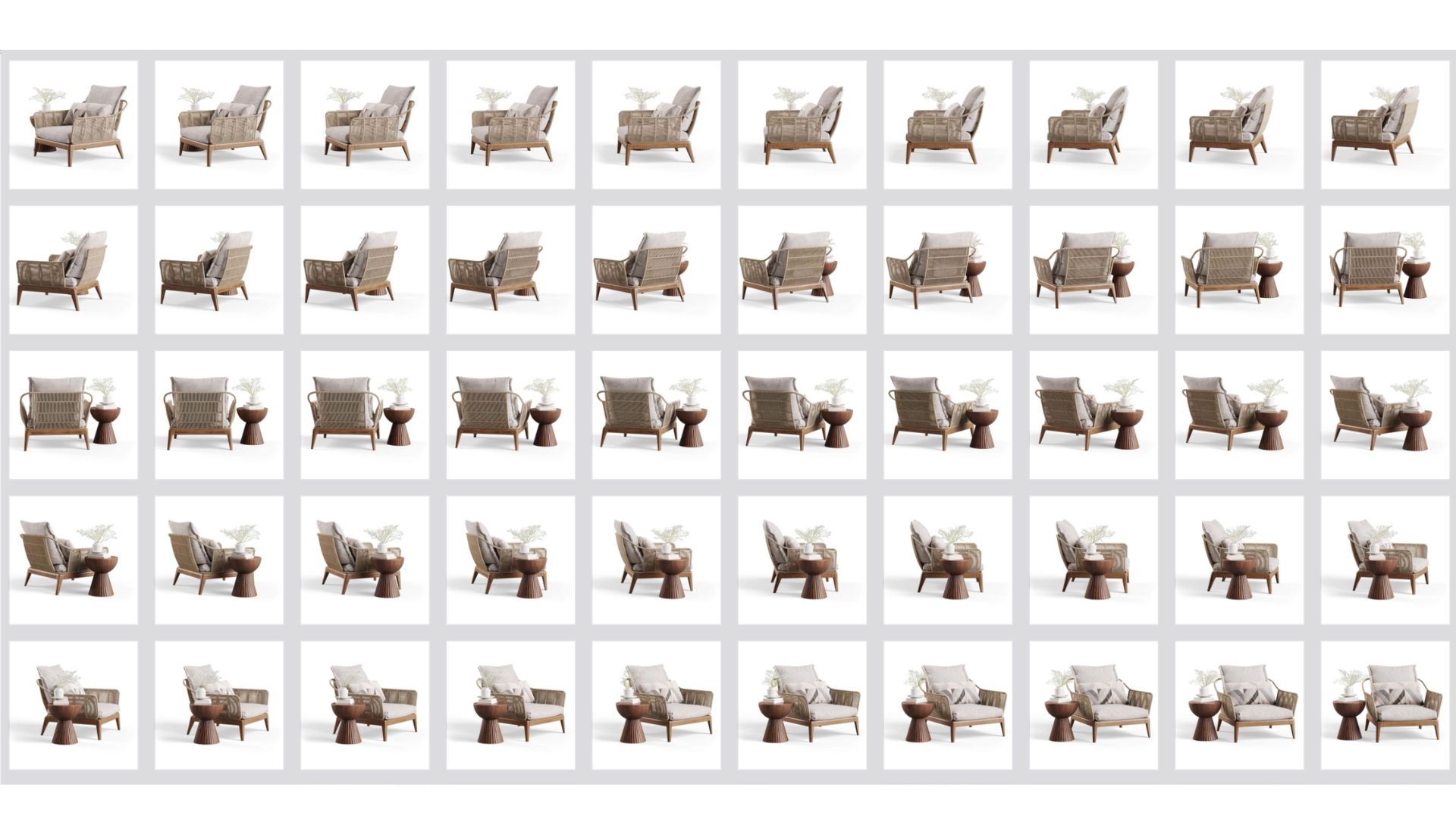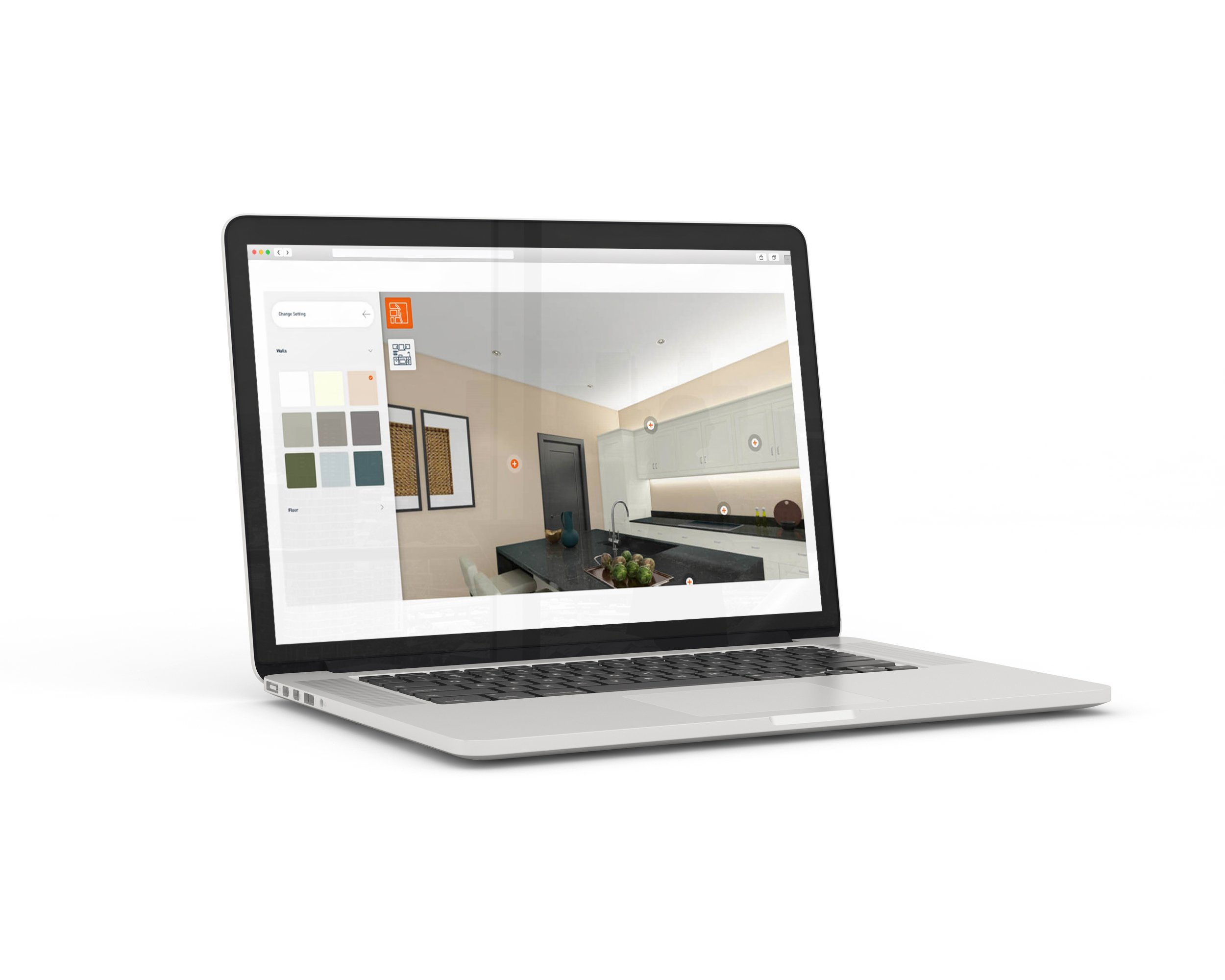In today’s marketplace, where competition is fierce and consumers are bombarded with information, a strong brand story can make all the difference. Digital 3D interactive product experiences can enhance your audience’s relationship with your brand, maximizing engagement and recall. By creating an immersive environment for users to engage in, you can showcase products or services effectively.
This article by our 3D modeling company outlines a comprehensive plan for utilizing interactive products as a powerful tool for brand storytelling.
Want to know how? Keep reading!
What is a 3D Interactive Product?
A 3D interactive product is a digital experience that allows users to engage with your product in a three-dimensional space. This means that users can interact with your product in a unique way, seeing all angles and components of the product in action. With 3D interactivity, users can engage with your product in an immersive environment, which helps them better understand and appreciate its features and value proposition.
Beyond enhancing your product showcase, interactive 3D experiences can also enable your brand story to come to life. Think of it as an opportunity to take your audience on a journey that showcases the essence of your brand and what sets you apart from your competitors. You can use 3D interactivity to highlight your product or service benefits, and provide unique insights into how it fits into the daily lives of your customers.
With 3D interactive products, you can create an experience that not only informs but also entertains your audience. Engaging and interactive experiences tend to leave a lasting impression on users, which contributes to long-term brand recall.
Here are 8 steps to integrate 3D interactive product models into marketing materials and channels to enhance your brand storytelling:
#1. Define Your Brand Story
Defining your brand story is a crucial step toward creating efficient brand storytelling through 3D interactive products. A deep understanding of your brand’s vision, mission, core values, and unique selling proposition (USP) is essential to achieve this. Here are some tips that can help you define your brand story:
- Embrace your core values: Your brand values reflect the essence of your business and shape your identity. By identifying these values, such as customer-centricity, sustainability, or innovation, you can weave them into the fabric of your brand story.
- Uncover your mission: The mission of your brand goes beyond selling products or services. Instead, it reflects your brand purpose and the positive impact you aim to make in the world. Ask yourself why your brand exists and how it can contribute to the lives of your customers.
- Highlight your unique selling points: Identifying what makes your brand different from others in your industry is essential to establish a unique selling point. When done correctly, these can differentiate you from competitors and form an integral part of your brand story.
- Understand your target audience: The ability to connect on a personal level with your audience is key to creating a compelling brand story. Tailor your story to their needs, desires, and pain points to fuel the creation of interactive experiences that truly engage them.
Once you have a clear understanding of your brand story, it’s time to align your 3D interactive product to fit its narrative. Consider every aspect of the product experience to reinforce your brand values, mission, and unique selling propositions. Doing so will help create an impactful and cohesive brand story that resonates with your audience.
Remember that facilitating an immersive and meaningful experience for your audience through 3D visuals is the key to successful storytelling. Stay authentic to your brand’s essence and communicate it effectively through interactive elements. By doing so, your audience will not only engage with your product but also connect with your brand on a deeper level.
#2. Choose the Right 3D Interactive Product

When choosing the right 3D interactive product, it’s important to consider your specific needs and goals. The website you provided showcases a 360-view 3D product rendering, which is a great example of an interactive 3D model. Here are some tips to help you make an informed decision:
- Engage with your target audience: Consider who your target audience is and what type of interactive experience would resonate with them the most. For example, if your audience is tech-savvy and open to new experiences, virtual reality (VR) might be a suitable choice. On the other hand, if your audience prefers simplicity and convenience, an augmented reality (AR) application or an interactive 3D model could be more appropriate.
- Define your marketing goals: Determine the specific goals you want to achieve through your 3D interactive product. Whether it’s showcasing product features, providing an immersive experience, or driving sales, each format has its own strengths and limitations. Evaluate how well each option aligns with your marketing objectives.
- Consider the nature of your products: The type of products you offer can also influence your choice of 3D product visualization. For example, if you sell furniture or decor items, a 360-view or interactive 3D model can allow customers to view the products from different angles and explore various options. If you offer complex machinery or equipment, a VR experience can provide a realistic and interactive simulation.
In our blog, there is an article that explains how each instrument of 3D interactive product technology works, from creating life-like static pictures for a 360° product view to using low-polygonal 3D models for a 3D configurator and creating photorealistic high-poly 3D models for 3D animation. If you are interested in exploring product modeling technologies further and learning how they can benefit your business, including brand storytelling, we recommend reading the “3D Modeling Technology: 3 Innovative CG Solutions for Product Promo”.
#3. Create an Immersive Product Experience
Creating an immersive product experience is essential to capture the attention and interest of your audience. Here are some additional tips to consider when designing your 3D interactive product:
- Storytelling through interactivity: Use interactive elements strategically to tell a story and guide users through your product experience. Consider incorporating interactive hotspots that provide additional information or highlight key features of your product. This allows users to engage with the product in a more meaningful way, increasing their understanding and connection with your brand.
- Gamify the experience: Add gamified elements to make the product experience more engaging and entertaining. This can include challenges, quizzes, or interactive elements that encourage users to explore different features or aspects of the product. By incorporating gamification, you not only make the experience enjoyable but also increase user interaction and time spent with your brand.
- Virtual reality (VR) and augmented reality (AR): Consider leveraging VR or AR technologies to create a truly immersive experience. VR allows users to step into a virtual environment and interact with products in a realistic way, while AR overlays digital elements onto the real world, allowing users to visualize products in their own space. These technologies can provide an unparalleled level of immersion and engagement.
- Seamless integration throughout marketing channels: Ensure that your 3D interactive product seamlessly integrates with your website, social media platforms, and other marketing channels. This allows for a consistent and cohesive brand experience across different touchpoints, strengthening your brand identity and message.
Remember, the goal is to create an immersive product experience that not only showcases your products but also resonates with your audience on an emotional level. By incorporating interactive elements, personalization options, gamified experiences, and leveraging VR or AR technologies, you can create a smart and captivating experience that aligns with your brand story and leaves a lasting impression on your audience.
#4. Integrate Brand Storytelling Elements
To create a truly engaging and memorable 3D interactive product experience, it’s essential to incorporate storytelling elements that align with your brand’s narrative. By doing so, you can capture your audience’s attention and establish a deeper connection with them.
Use visual cues and design elements that reflect your brand’s aesthetics and messaging. Consider incorporating your brand’s colors, fonts, and visual style into the 3D interactive product. This creates a cohesive brand identity and helps reinforce your brand’s narrative throughout the experience.
Bring your creations to life through product animations and dynamic visuals. Use 3D animations to showcase key features, demonstrate functionality, or illustrate how the product can be used or was designed. By adding motion and interactivity, you can create a more engaging and immersive experience for your audience.
#5. Personalize the Experience
To create a truly exceptional 3D interactive product experience, personalization is key. By tailoring the experience to each individual user, you can make them feel connected, engaged, and valued. Here are some strategies to help you personalize the 3D interactive product experience:
- Utilize user data: Gather user data through various touchpoints, such as website interactions, previous purchases, or surveys. Use this data to understand your users better and tailor the experience accordingly. For example, if a user has previously shown interest in a particular product category, you can highlight relevant options or provide personalized recommendations within the 3D interactive product.
- Customizable options: Offer users the ability to customize their experience based on their preferences. This can include adjusting visual settings, selecting their preferred language, or even modifying the layout or interface of the 3D interactive product. By giving users control over their experience, you empower them and make it feel more personalized.
- Dynamic content: Make use of dynamic content to adapt the experience in real-time. For instance, if a user has indicated a preference for certain colors, textures, or styles, you can dynamically update the visuals within the 3D interactive product to reflect their choices. This level of customization will make users feel like the experience was specifically created for them.
- Contextual recommendations: Based on user behavior or preferences, provide contextual recommendations within the 3D interactive product. For example, if a user is exploring a specific product, suggest related items or accessories that might complement their selection. This not only enhances user engagement but also increases the likelihood of upselling or cross-selling.
- Interactive feedback and surveys: Incorporate interactive feedback and surveys within the 3D interactive product to gather user preferences and opinions. This information can then be used to further personalize the experience or improve future iterations. By actively involving users in the customization process, you enhance the overall engagement and satisfaction.
Remember, personalization is about creating a unique and tailored experience for each user, making them feel valued and connected to your brand story. By utilizing user data, offering customizable options, providing dynamic content, giving contextual recommendations, and incorporating interactive feedback, you can elevate the 3D interactive product experience to a new level of personalization.
#6. Leverage Story-Driven Interactions
To truly captivate your audience and create an engaging 3D interactive product experience, it’s important to leverage story-driven interactions. By incorporating interactive scenarios within the product that allow users to directly engage with your brand story, you can create a memorable and immersive experience that resonates with them. Here are advices to help you leverage story-driven interactions in your 3D interactive product:
- Define interactive scenarios: Identify key moments or elements from your brand story that can be transformed into interactive scenarios. For example, if your brand story revolves around adventure, consider creating interactive challenges or quests within the virtual environment that users can participate in. These scenarios should align with your brand narrative and create a sense of excitement, curiosity, or achievement.
- Establish clear objectives and goals: Clearly define the objectives and goals of each interactive scenario. This will provide users with a sense of purpose and direction as they engage with the product. Whether it’s completing a challenge, solving a puzzle, or achieving a specific outcome, having clear objectives will keep users motivated and engaged throughout the experience.
- Provide meaningful choices: Offer users the opportunity to make meaningful choices that impact the outcome of the interactive scenarios. This not only adds an element of personalization but also allows users to feel more involved in shaping the brand story. Consider incorporating branching narratives or multiple pathways that users can explore, each leading to a different outcome or experience.
- Feedback and rewards: Provide immediate feedback and rewards based on user interactions and progress. Positive reinforcement, such as unlocking new content, earning badges, or receiving virtual rewards, can enhance user engagement and motivate them to continue exploring the interactive scenarios. This also creates a sense of accomplishment and makes the experience more immersive and enjoyable.
- Continuity and relevance: Ensure that the interactive scenarios seamlessly integrate into the overall 3D interactive product experience. They should feel like a natural extension of the brand story and contribute to the narrative progression. Avoid disconnected or unrelated interactions that may disrupt the flow or coherence of the product experience.
By leveraging story-driven interactions, you can create a 3D interactive product experience that not only showcases your brand but also allows users to actively participate in the brand story. The combination of interactive challenges, meaningful choices, feedback and rewards, and continuity in the experience will make it memorable, and impactful.
#7. Integrate Social Sharing and User-Generated Content
To create truly impressive brand storytelling with 3D interactive product experience, it’s important to incorporate social sharing and user-generated content. By encouraging users to share their experiences with the product on social media platforms and allowing them to create and share their own customized versions of your products, you can expand your brand’s reach and foster a sense of community. Below are some strategies to adopt:
- Social sharing buttons: Make it easy for users to share their experiences with the 3D interactive product by incorporating social sharing buttons or features within the experience itself. Include buttons for popular social media platforms like Facebook, Instagram, Twitter, or Pinterest. This allows users to share screenshots, videos, or even snippets of their interactions with just a click, extending the reach of your brand and generating organic buzz.
- Incentivize sharing: Offer incentives or rewards to users who share their experiences on social media. This can be in the form of exclusive content, discounts, or even sweepstakes entries. By providing extra motivation, you can encourage more users to share their interactions, helping to create a buzz around your 3D interactive product and attracting new users to try it out.
- User-generated content: Allow users to create and share their own customized versions of your products within the 3D interactive experience. Provide tools or features that enable users to personalize colors, textures, or other aspects of the products. Users can then share their creations on social media, showcasing their unique styles and preferences while promoting your brand. This not only increases user engagement but also serves as a form of social proof, inspiring others to get involved and try out the 3D interactive product.
- Community engagement: Foster a sense of community by acknowledging and engaging with users who share their experiences or create user-generated content. Respond to their posts, showcase their content on your brand’s social media accounts, or even feature their creations within the 3D interactive product itself. This not only builds a strong connection with your audience but also encourages ongoing participation and advocacy.
- Collaborations and contests: Consider partnering with influencers or running contests that encourage users to create and share their own content using the 3D interactive product. This can help generate excitement, increase brand visibility, and attract new users who are eager to participate and showcase their creativity.
By integrating social sharing buttons, incentivizing sharing, allowing user-generated content, fostering community engagement, and exploring collaborations and contests, you can leverage the power of social media to amplify the impact of your 3D interactive product. Encouraging users to share their experiences and creations not only extends your brand’s reach but also creates a sense of belonging and excitement surrounding your product.
#8. Analyze and Iterate
To create a successful and impactful 3D interactive product, it’s important to track user engagement, analyze feedback, and continually iterate on the experience to improve it over time. By collecting and analyzing data on user behaviors and preferences, you can gain valuable insights that can inform future updates and improvements to the product. Here are some tips to help you analyze and iterate on your 3D interactive product:
- Set clear goals: Define clear goals and metrics for the 3D interactive product before launching it. Identify the key metrics you will track, such as user engagement, time spent in the experience, conversion rates, or social media shares. This will help you measure the success of the product and identify areas for improvement.
- Collect and analyze data: Use analytics tools to collect data on user interactions, behaviors, and feedback. This can include user surveys, heat maps, click-through rates, or qualitative feedback. Analyze the data to identify patterns, trends, and areas of opportunity. Use this information to iterate and improve the experience over time.
- Identify pain points: Identify the pain points or areas of friction in the user journey. It could be technical issues, confusing navigation, or a lack of clarity in the brand story. Address these issues by updating the product or providing additional guidance to users. This will help to improve the overall user experience and increase engagement.
- Test and experiment: Experiment with new features, content, or interactions to see how users respond. A/B testing can be an effective way to gauge user preferences and optimize the experience. Test different versions of the product to identify which features or interactions are most effective at engaging users and driving conversions.
- Iterate and improve: Continually iterate and improve on the 3D interactive product, using the insights and feedback gathered from users. Make regular updates and improvements to the product to ensure that it stays fresh, relevant, and aligned with user preferences and trends.
By consistently tracking user engagement, analyzing feedback and metrics, and iterating on the experience, you can create a 3D interactive product that evolves with your audience and continues to resonate over time. For more guidance on analyzing and iterating on your 3D interactive product, reach out to me with specific questions or concerns.
Adding 3D interactive content to your brand’s storytelling strategy can help you reach customers in new and exciting ways. By following this comprehensive plan, you can create immersive experiences that captivate your audience and forge a deeper connection with customers. Embrace the power of 3D interactive products to shine and inspire.
At CGIFurniture, we take pride in offering exceptional 3D modeling services that can transform your products like never before. With our cutting-edge photorealistic rendering and animation techniques, we can help you present your products in captivating visual contexts, all without the need for costly and time-consuming photo shoots. Whether your products are high-end or casual, our tailored 3D solutions are designed to showcase their unique features with incredible detail and customization.
By choosing CGIFurniture, you can elevate your brand storytelling, captivate your customers, and create a lasting impact with 3D interactive product technology. To discover more about our CGI services, contact us now!











Leave a Reply
Want to join the discussion?Feel free to contribute!